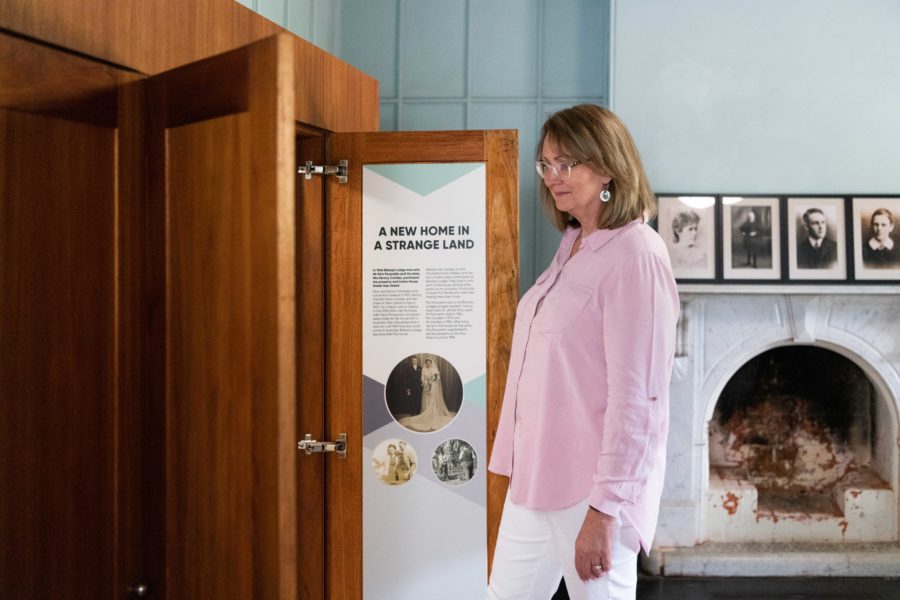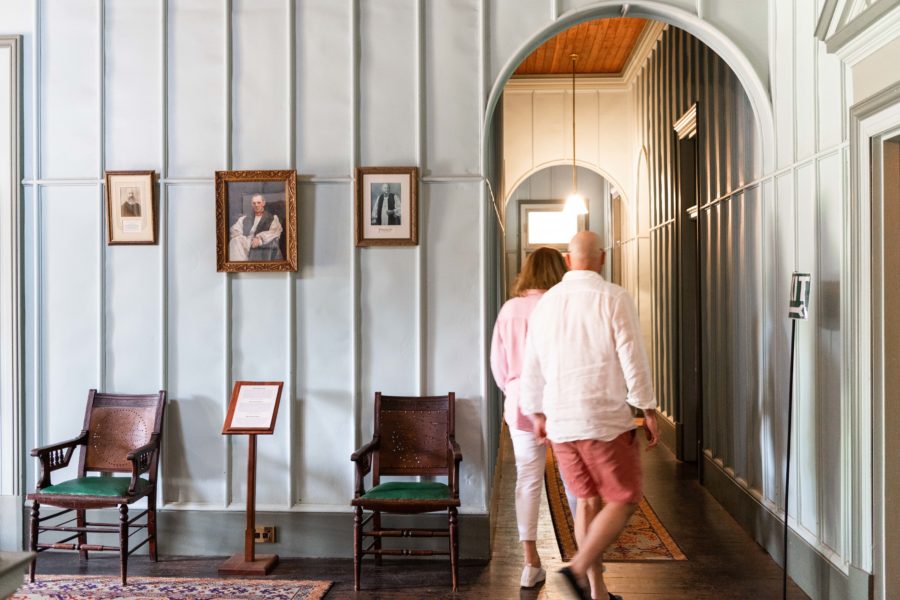Bishop's Lodge is an extraordinary 1888 iron house, designed by architect John Sulman with the first Anglican Bishop of Riverina, Sydney Linton. Their aim was to create a comfortable home to withstand Hay's summer heat and difficult soils. Even today the technology evident in this design is significant. The Bishop's Lodge is surrounded by a wonderfully cool historic garden that features a remarkable collection of heritage roses.
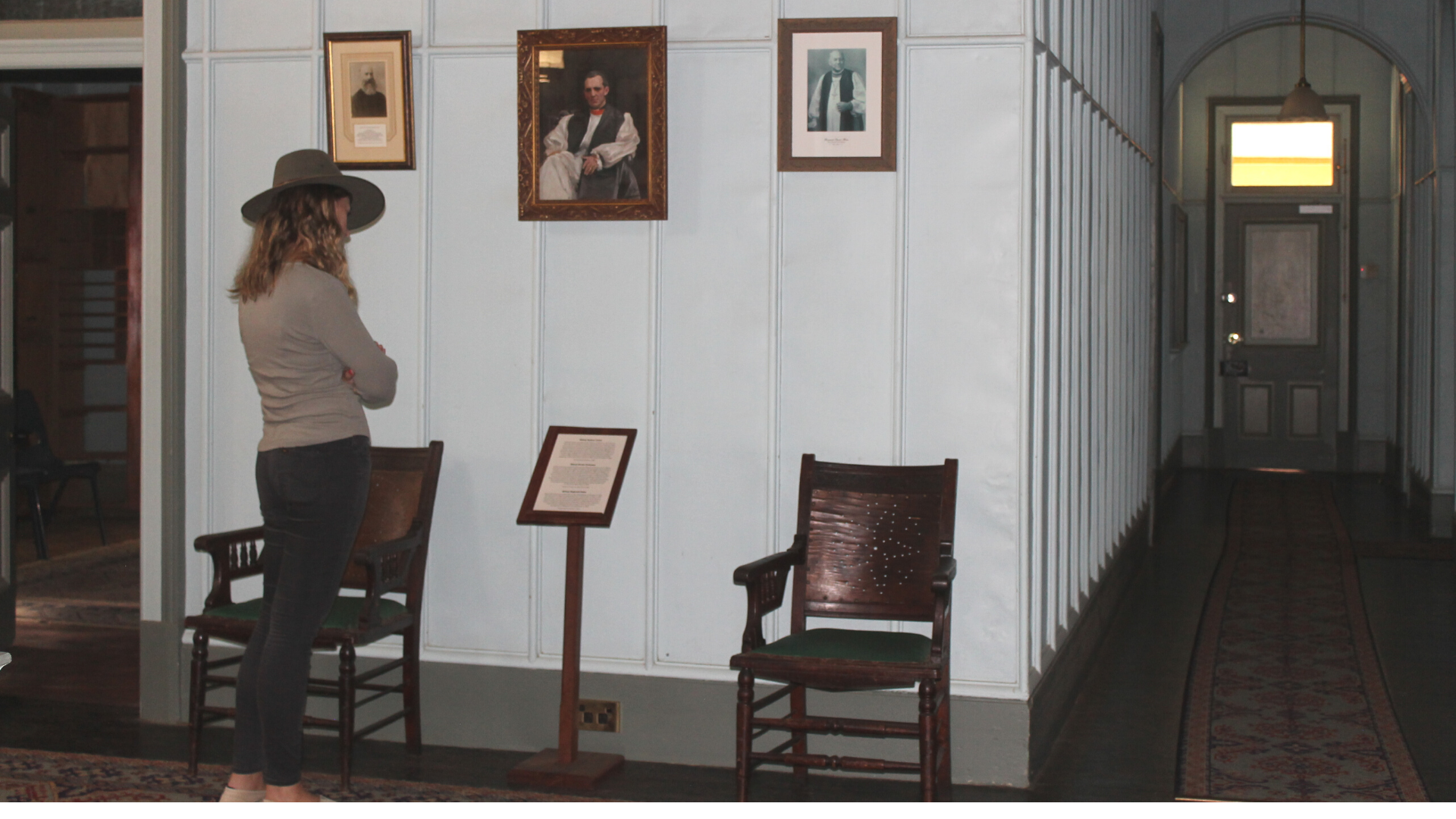
About the house
Bishop’s Lodge is a remarkable iron building constructed in 1889 as the official residence for the Anglican Bishop of Riverina.
The house and its 19th-century garden are now maintained as a house museum by the Bishop’s Lodge Management Committee.
Owned by the Anglican Diocese until 1946, the Lodge was home to the first three bishops -Sydney Linton, Ernest Anderson, and Reginald Halse. Between 1935 and 1946 it also became the Linton House hostel for boys attending the Hay War Memorial High School. From 1946 until 1985 it was a private residence.
In 1985 the Hay Shire Council purchased the property and obtained several large grants which enabled the physical conservation of the property to take place. This became Hay’s major bicentennial project for 1988. The work was completed over the years 1986 -1990.
When Bishop’s Lodge was built in 1888-9 it cost £6,800 (pounds), approximately AU$902,000 (2015)
It was sold in 1946 for £1,200 (pounds). It was then sold to the Hay Shire Council in 1985 for $85,000.
Grant monies of $332,000 were used to fund the conservation of the building.
Current income is raised by the Bishop’s Lodge Management Committee through fundraising, function hire, tours and visitors, grant monies and an annual vote from the Hay Shire Council.
Technology in the House
- designed by celebrated architect Sir John Sulman with substantial input by Bishop Sydney Linton
- built by local contractors Butterworth and Sylvander
- use of iron exterior walls and zinc-coated tin plate interior walls with cedar batten strapping over the plate joints in most rooms, plaster in public rooms.
- walls insulated with saw dust
- cyprus pine timber, resistant to termite attack was used throughout the house
- raised ventilating ridging on the hips and ridges of the roof, ventilators under the eaves for all rooms and substantial footings to allow for free movement of air circulation under the building
- low window sills on double hung windows with boxed counter weights allow for the windows to be opened low down or high up to better the ingress of cool air from the verandahs and the egress of hot air from the rooms
- separate kitchen block to keep the house cool and minimise the risk of fire spreading
- recycled tank stands, formerly for harvesting rainwater
- stained glass windows in the private chapel
- a total area of about 115 squares (978 sq metres), 45 of which are verandah
- kitchen block is an extra 14.5 squares
- verandahs are 9 feet deep (2.7 metres)
- ceiling height is 14 feet (4.3 metres)
- there are 24 rooms in the house including a dining room, a drawing room, a sitting room, several bedrooms and chapel.
The Families and occupants
The Lintons 1889-1894
Andersons 1895-1925
Bishop Halse 1926-1943
Linton Hostel 1935-1946
The Panarettos and Carides families 1946-1985
Hay Shire Council with the Bishop’s Lodge Management Committee 1985-present
Collection Policy
Bishop’s Lodge will collect and conserve important objects associated with the history of the Bishop’s Lodge House and Garden. The themes of the collection include:
- innovative building technology suited to hot dry climates
- gardening in hot, dry climates
- the early history of the Riverina Diocese of the Anglican Church
- the life of the families who have lived at Bishop’s Lodge
- the Linton House hostel period
- the conservation of the property
- the management of the property
- the contribution of the volunteers
- the ‘found’ roses in the garden
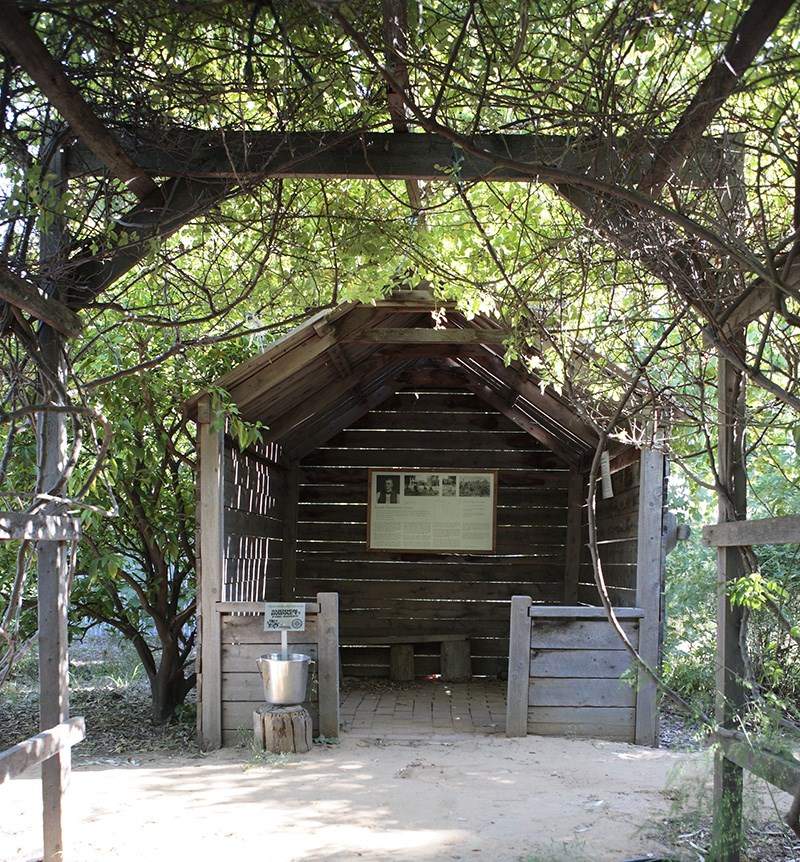
The gardens
When the Linton family moved into Bishop’s Lodge in September 1889 the home grounds comprised eight acres. Here the ground was ploughed to a depth of 18 inches and four hundred trees, fruit and ornamental trees were planted over a three month period that spring. A further 13 acres of paddock lay immediately to the south. This was an area subject to flooding by the Bungah Creek, the Bishop Linton felt it would be exceedingly valuable for the cultivation of horse feed and fruit trees if irrigated. It was separated from the Lodge by a road, Moama Street, which is now the Sturt Highway.
Ah Mow, the Chinese gardener, had been engaged by Bishop Linton in the early 1890s and was still part of Bishop’s Lodge in 1921. It is not clear how long after this he was there and some mystery surrounds his death.
There was a formal entrance from Lang Street and, from as far back as Bishop Anderson’s time, the Roset Street entrance has been the ‘front gate’. The wide access to the river, which was directly in line with the front door, was generally used as a footpath. Flanking this path were pine trellises on which Ah Mow grew all kinds of black and white table grapes. Rosemary and lavender grew below the trellis. The current plantings to the north of the house are a nod to that concept. Ah Mow kept a vegetable garden on the south of the building and another in the north west corner of the grounds. He also tended an extensive orchard of pear, apple, plum, peach, nectarine and apricot trees.
By about 1915 the view from the front verandah was one of well-kept lawns and beautifully tended gardens on every side. There were large rose bushes in the middle of the circular lawn and well grown scrubs on either side of the front garden. Pepper and plane were the dominant trees.
The rose garden to the north of the driveway was established by Bishop Anderson 1895 - 1915. Bishop Anderson was an enthusiastic gardener and loved his roses. He was both a keen grower and an enthusiastic exhibitor.
Pencil pines and a date palm on the circular front lawn were planted about 1931- 1935.
What is now referred to as the ‘hidden garden’ was originally an enclosed garden visible from the entrance, but subsequent growth has concealed it. Some of the original posts and wire netting remain; small chicken wire below and larger gauged marsupial wire above. Lemon and orange trees were planted around beds in the rose garden. During Bishop Anderson’s time there was a summer house in the enclosed garden. Built of timber with seating within, it was approached via a central path beneath a rose-covered archway. This summer house was reinstated in the late 1980s.
By 1988 the grounds had been reduced to 3.5 acres. After 1985 a number of plants were cleared to facilitate conservation work, including a massive wisteria and gardenia which grew against the verandah.
50 roses were found still growing in the garden. 32 were different old varieties and another 50 were planted in the eastern front lawn in beds to correspond with earlier beds that bounded the driveway. By 1996 some 21 old roses were still unidentified. 11 have possible identities and 6 have been identified as being pre 1925. Two old roses were lost accidentally. The process of identification of the unidentified ‘found’ roses is ongoing. These original roses are named for someone who has been part of Bishop’s Lodge. These include family members, the gardener and the architect. Each of these is prefaced by Bishop’s Lodge. Bishop’s Lodge Sydney Linton is the signature rose. In 1992 the Roset Street rose hedge of 30 roses was planted. The kitchen garden was re-established in 1994 and in 1996 the picking garden was planted with 95 roses, 11 nut and fruit trees. There are now some 350 rose bushes established in the garden.
Roses from the garden are budded onto hardy understock by specialists and are available for sale to the public.
In recent years a collection of trees and shrubs native to the district has been added to the garden and a planting of trees, shrubs and rose hedges form a screen from the highway.
The guiding principles of maintaining the garden are sustainability and the acknowledgement of the original designs and concepts, albeit in a much smaller space. From 1985 the practice of watering infrequently but deeply and using mulch to conserve moisture has helped the garden survive many years of drought and higher temperatures.
The Heritage Act 1977 protects all existing trees.
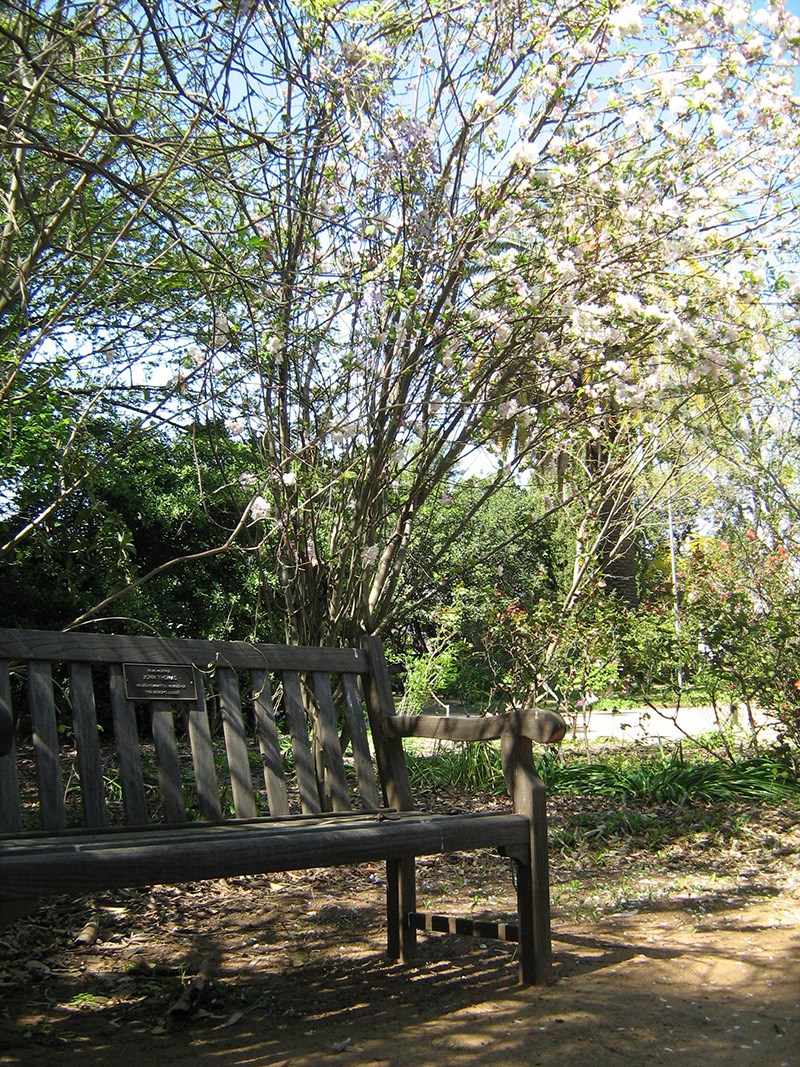
Roses and Souvenirs
The Bishop's Lodge garden is one of the oldest in the Riverina. Tended by a dedicated group of volunteers, the garden combines historic trees, sweeping lawns, native plantings and a hidden garden featuring the original roses.
SWEET PEAS
Price: $2 per packet
From the original strain of sweet pea, sent to England in 1699 by Franciscus Cupani, a Sicilian monk. Colourful burgundy and purple bi-colour blossoms with a very strong fragrance.
We recommend they go into the ground on Saint Patrick's Day or up until Anzac Day if the weather is still very warm.
THE BISHOP'S LODGE BOOK
Price: $10 each
The Bishop's Lodge, Hay, New South Wales, Australia: a history and a guide by Mary Lou Gardam.
BOOKMARK
Price: $12 each or $30 for 3
A beautifully crafted, quality metal bookmark.
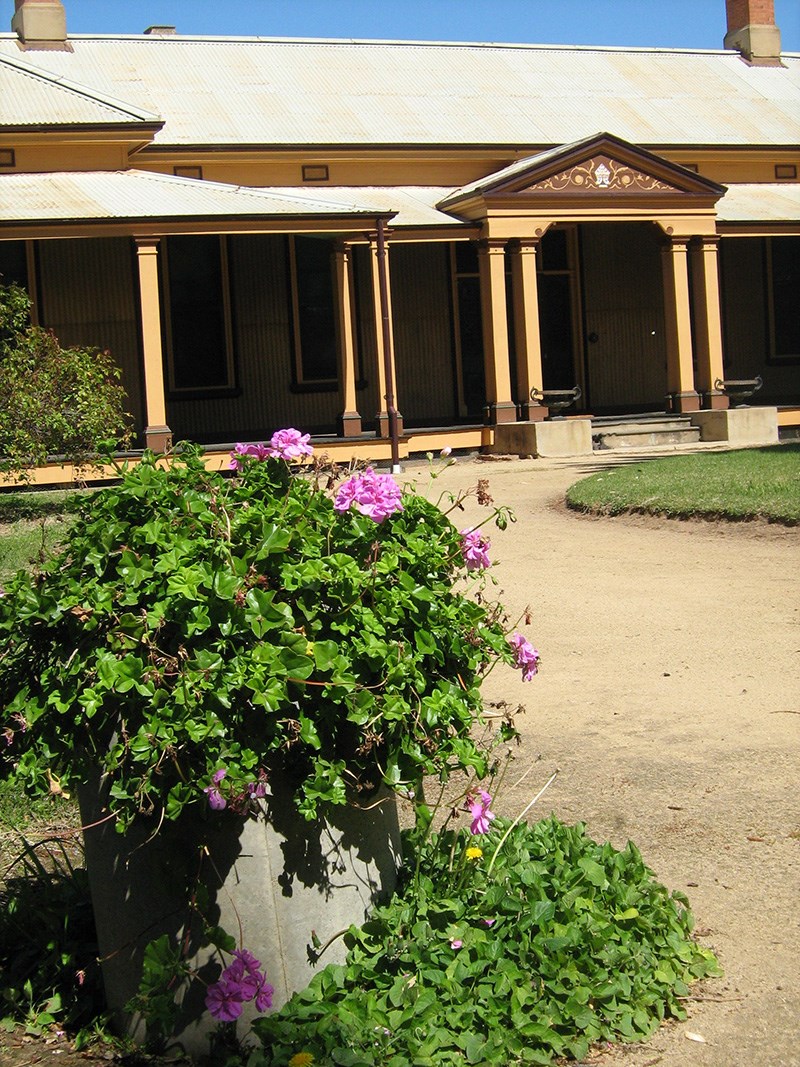
Volunteering
There are several ways in which you could become involved with Bishop’s Lodge.
As a Volunteer
Volunteers of any age are welcome and there is no cost involved
- join our rose pruning days where lunch is provided. Both experienced and those new to rose pruning are both welcome.
- come along and work in the garden
- help with the collection
- assist with an event
- assist with catering in some way
Please contact us by phone or email or use the Feedback form on the Home Page
Explore nearby
Booroorban
Booroorban, New South Wales 2710
Booroorban is a village 55km South of Hay on the Cobb Highway. This little village has a passionate community, a great hotel and a farm stay not to miss.
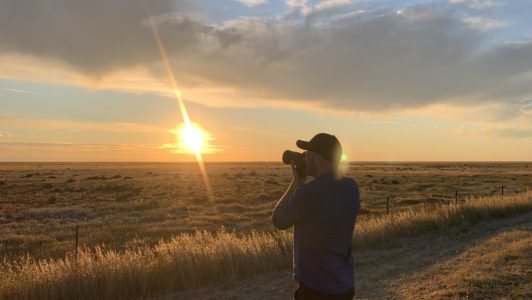
Sunsets
Hay, NSW
Enjoy the unique experience of seeing the sunset with a 360-degree uninterrupted view. The perfect spot for photographers or those wanting to enjoy a traditional “sundowner” as the sun sets over the vast Hay Plains. Located just 16km north of Hay on the Cobb Highway the Sunset Viewing area features a Long Paddock information panel…
One Tree
Located between Hay and Booligal on Cobb Highway is the famous and historic One Tree Hotel. The hotel was built in 1862 by Alexander Finch. Originally known as Finch Inn, it was renamed the One Tree Hotel later when purchased by William Clark. It was named because of a lone large gum tree growing on…

